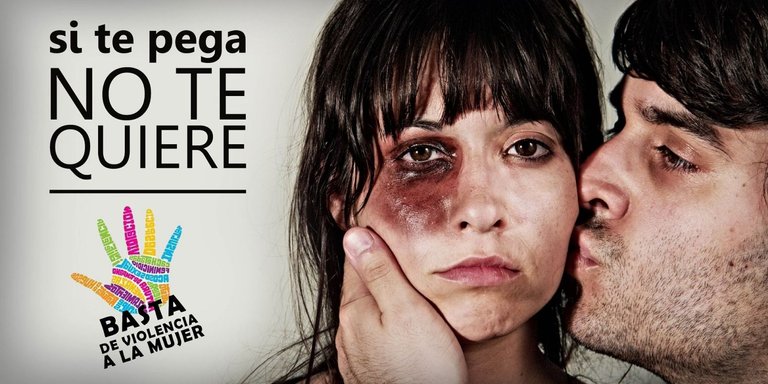

Violence against women is exercised because of their status as women. This being "a consequence of the discrimination that suffers both in laws and in practice, and the persistence of inequalities for reasons of gender".
In this violence there are many facets ranging from discrimination and disparagement to physical, sexual, verbal or psychological aggression and murder, manifesting in various areas of social life, work and politics, including the family itself , the school, the Church, the State, among others.
In 1993, in a general assembly, the United Nations (UN) approved the Declaration on the elimination of violence against women, and in 1999, on the proposal of the Dominican Republic with the support of 60 more countries, declared on November 25. International Elimination of Violence against Women.
In 2008, the UN Secretary General launched the "UNids to End Violence against Women" campaign, appealing to the "rule of law" as a vehicle for its eradication. One of its objectives was to ensure that by 2015 all countries have adopted specific laws against this type of violence in accordance with international standards on human rights.
In February 2008, United Nations Secretary General Ban Ki-moon launched the UNiTE campaign to end violence against women, proclaiming the 25th of each month, Orange Day. Among other activities, on that day is invited to wear a garment of that color to highlight the call to eradicate violence against women.

Introduction.

The United Nations defines violence against women as "any act of gender-based violence that results in or may result in physical, sexual, psychological or economic harm to women, including threats of such acts, coercion or arbitrary deprivation. of freedom, whether they occur in public or private life ", 4 5 recognizing it as a pandemic that affects 55% of the world's population, with up to 70% of women victims of that violence in some moment of his life.6 Violence against women affects families and communities of all generations and reinforces other types of violence prevalent in society:
In 2014, according to the data available from the UN: (Website updated to 2016)
38% of the murders of women perpetrated in the world are committed by their partner, being the family and couple where the largest number of cases of violence against women, whether physical, sexual or psychological occurs. 50% of murders of women in the world are committed by a family member or partner and 35% of women have suffered physical or sexual violence by their partner.
Some 120 million girls around the world, more than one in 10, have suffered at some point forced coitus or other forced sex.
Trafficking in persons becomes a trap for women and girls who are 98% the object of sexual exploitation (4.5 million people in the world).
More than 133 million girls and women have suffered some type of genital mutilation.
Being a girl would be one of the risk factors, along with belonging to a disadvantaged class or a minority. 700 million women living in the world today were married with less than 15 years, being more vulnerable to violence by the husband.
In armed conflicts systematic rape becomes a weapon of war (between 250,000 and 500,000 women were raped during the 1994 genocide in Rwanda and it is estimated that between 20,000 and 50,000 during the early Bosnian conflict 1990s).
And femicide is shown by comparative figures: in the world, two women are murdered for each murdered man. And the percentage of women is 65% of approximate victims due to domestic violence.
This violence against women and girls exercised by reason of their sex would find its root in the historical power relations between men and women, in the patriarchal social model that has favored relations of dominance of this over it, the inequality between the sexes and the discrimination .
It would have been the feminist movements that since the late nineteenth century and mainly during the last century, the twentieth century, gave visibility to the condition of women, achieving in the mid-twentieth century that violence against women was no longer considered a private matter. a social and public problem. Since then, public perception has become aware of the real dimensions of the problem, and international and national organizations are joining and actively working to eradicate it, enacting laws and promoting awareness campaigns. As of today, it can not be doubted that violence against women is a global problem that affects the most basic human rights of more than half of the world's population and that must be eradicated.
Having recognized that violence against women has its causes in discrimination and inequality, combating that discrimination and inequality means at the same time addressing that violence.
Violence against women treated in the agencies oficiales.

Since 1975, the World Conference on Women has been held as a way of incorporating the topic into public policy, and in 1993 the United Nations ratified the Declaration on the Elimination of Violence against Women8 which states that this violence is a serious attack against the human rights of women and girls, recognizing "the urgent need for universal application to women of the rights and principles relating to equality, security, freedom, integrity and dignity of all human beings" ; also recognizing the role played by organizations for the rights of women, organizations that facilitated giving visibility to the problem.
Violence against women being a problem that affects human rights, which "constitutes a manifestation of historically unequal power relations between men and women, which have led to the domination of women and discrimination against them. of man and impeded the full advancement of women, and that violence against women is one of the fundamental social mechanisms by which women are forced into a situation of subordination to men ", sees the need to define it clearly as a first step so that, mainly the States, assume their responsibilities and there is "a commitment of the international community to eliminate violence against women".
The declaration includes six articles defining violence against women and the forms and scopes of this violence, while enumerating the rights of women to achieve equality and their full development and urging States and international organizations to develop strategies and put the means to eradicate it.
In the same sense, on March 5, 1995, the "Inter-American Convention to Prevent, Punish and Eradicate Violence against Women: Convention of Belém do Pará" was adopted.
External link with the United Nations Declaration.
External link with the "Convention of Belém do Pará"
In 1999, on the proposal of the Dominican Republic with the support of 60 more countries, on November 25, the International Day for the Elimination of Violence against Women was declared. The date of November 25 was chosen to commemorate the Mirabal sisters, three political activists who were brutally murdered in 1960 by order of Dominican ruler Rafael Trujillo.
In Canada, National Day of Remembrance for victims of violence against women is celebrated on December 6, in commemoration of the massacre of the Polytechnic School of Montreal.
Terminology.
"Violence against women" is the term used by the UN to refer to violence against women because of their sex, defined as: "any act of violence based on belonging to the female sex that has or may have as resulting in physical, sexual or psychological damage or suffering for women, as well as threats of such acts, coercion or arbitrary deprivation of liberty, whether they occur in public life or in private life. " widely used term.
Another widely used term is «gender violence», although this other term would be less specific, since it would encompass all violence determined by sex or gender, «refers to that directed against a person because of the gender that he or she she has, as well as expectations about the role he or she must fulfill in a society or culture. "One and the other terms are often used interchangeably.}
The term "gender violence" emerged in the mid-twentieth century from areas of feminism to give visibility to the violence exercised against women because of their status as women as a result of the historical fact of patriarchy. This term would have the disadvantage of its possible abstraction if it is not contextualized in the power relations between the sexes that penalize women and is the reason why, although it can be a victim of gender violence regardless of gender, it is women and girls the majority affected.
The concepts of gender and patriarchy have become two fundamental concepts, both for their elaborate capacity for synthesis to refer to a complex reality, and for their widespread acceptance by the feminist and academic community.
It is also of use "sexist violence", a more explicit term that would not designate the violence necessarily committed by men, but that exercised by sexist motivations.
More specific terms, according to the types of violence, are: domestic violence, violence in the couple, violence in the family, femicide, etc.

It is a very complicated issue but if you suffer from mistreatment do not shut up because silence hurts more than what they hit you, do not call streets call a relative, neighbor or police but do not let them continue to mistreat you no longer be a victim of domestic violence, NO STREETS, SPEAK
Nunca habrá suficiente literatura sobre el tema de la violencia y el poder, y en especial el poder ejercido sobre la mujer en forma de violencia. Buen artículo!
GRACIAS
Nunca habrá suficiente literatura sobre el tema de la violencia y el poder, y en especial el poder ejercido sobre la mujer en forma de violencia. Buen artículo!